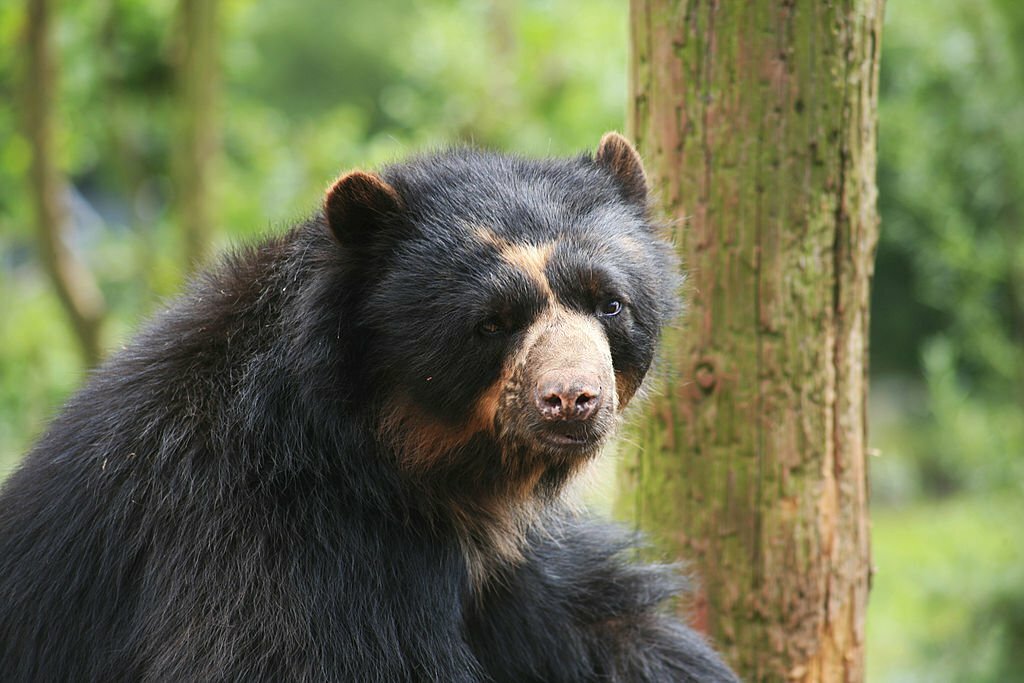In the breathtaking landscapes of Peru, where the Andes Mountains weave a tapestry of rugged terrains and lush forests, roams an elusive and charismatic creature – the Andean bear, also known as the spectacled bear (Tremarctos ornatus). As the only bear species native to South America, these bears play a crucial role in the ecological balance of high-altitude ecosystems, captivating the hearts of those fortunate enough to catch a glimpse of these enigmatic beings.
1. Unique Appearance:
Named for the distinctive circular, light-colored markings around their eyes that resemble eyeglasses, Andean bears are instantly recognizable. Their shaggy fur ranges in color from black to brown, and they possess a robust build, adapted to navigate the challenging terrains of the Andes.
2. High-altitude Habitats:
Andean bears are primarily found in the cloud forests and high-altitude grasslands of the Andes, making Peru a crucial stronghold for their survival. These bears are known for their ability to thrive in elevations ranging from 6,000 to 15,000 feet above sea level, making them the only bear species adapted to such high altitudes.
3. Guardians of Biodiversity:
As omnivores, Andean bears have a varied diet that includes fruits, berries, vegetation, and small mammals. Their foraging habits contribute to seed dispersal, promoting the growth of diverse plant species. By influencing the distribution of plant life, Andean bears indirectly support the biodiversity of their ecosystems.
4. Threatened Status:
Despite their ecological significance, Andean bears face significant threats that jeopardize their survival. Habitat loss due to agricultural expansion and logging, as well as human-wildlife conflicts, pose substantial challenges to these bears. Conservation efforts are critical to protecting their habitats and mitigating conflicts with local communities.
5. Conservation Initiatives:
In Peru, conservation organizations and governmental bodies are actively engaged in initiatives to protect Andean bears and their habitats. These efforts include the establishment of protected areas, community-based conservation projects, and educational programs aimed at raising awareness about the importance of coexisting with these remarkable creatures.
6. Spectacled Bears in Culture:
Andean bears hold cultural significance in the folklore and traditions of indigenous communities in the Andean region. They are often revered as symbols of strength and wisdom, with stories and myths featuring these bears as mystical guardians of the mountains. This cultural connection adds an extra layer of importance to their conservation.
7. Research and Monitoring:
Scientific research plays a crucial role in understanding the behavior, ecology, and population dynamics of Andean bears. Researchers employ various techniques, including camera traps and radio collars, to monitor these elusive creatures in their natural habitats. This knowledge is invaluable for implementing effective conservation strategies.
8. Responsible Wildlife Tourism:
As interest in wildlife tourism grows, responsible initiatives have emerged to offer opportunities for travelers to encounter Andean bears ethically. Guided tours that prioritize the well-being of the bears and their habitats contribute to both conservation efforts and the education of the public about the importance of preserving these unique ecosystems.
9. Climate Change Impact:
The effects of climate change pose additional challenges to Andean bears. Changes in temperature and precipitation patterns can impact the distribution of the bear’s preferred vegetation and alter their habitats. Conservation strategies must consider the broader impacts of climate change on these high-altitude ecosystems.
In conclusion, the Andean bear stands as a symbol of resilience and adaptability in the face of environmental challenges. As guardians of high-altitude ecosystems, these bears play a vital role in maintaining biodiversity and ecological balance. Conservation efforts in Peru and beyond are essential to ensure the survival of the Andean bear and the preservation of the stunning landscapes they call home. By fostering coexistence between humans and bears and addressing the threats they face, we can contribute to the continued existence of this remarkable species in the heart of the Andes.
book here.










Comment (0)